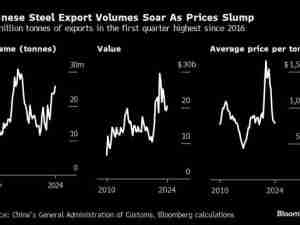U.S. Is Said to Demand Steel Tracking in Nafta Push on Autos
By: Josh Wingrove, Eric Martin and Joe Deaux | Oct 13 2017 at 03:15 PM | International Trade
The U.S. wants to include steel in Nafta’s tracing list and hike the share of a car that originates in America, moves that may increase costs and red tape for automakers, two officials familiar with negotiations said.
The steel proposal comes along with one of the Trump administration’s most high-profile demands so far in talks aimed at overhauling the North American Free Trade Agreement. The U.S. proposed late Thursday raising the so-called auto rules of origin to 85 percent from the current 62.5 percent, one official said, speaking on the condition of anonymity as discussions with Canada and Mexico are ongoing.
The rules govern what share of a product must be sourced within Nafta to receive the pact’s benefits. President Donald Trump’s negotiators have also proposed adding a new, U.S.-only content requirement of 50 percent, meaning it wants half of every car traded under Nafta to be built in the U.S., the official said. The 85 percent requirement would be phased in over multiple years, the official said.
Trump’s team also wants to add steel to the tracing list, in effect requiring proof of where the steel comes from, two officials said Friday. The U.S. proposed vastly expanding the list to include textiles, aluminum and other metals, one official said. A spokesperson for U.S. Trade Representative Robert Lighthizer declined to comment.
Pyrrhic Victory
Brett House, deputy chief economist at Bank of Nova Scotia in Toronto, said the rules of origin proposal would be a “potentially Pyrrhic victory” for Trump because automakers would just pay the U.S.’s 2.5 percent tariff to import cars into the country rather than deal with the complicated set of rules for Nafta.
If it were to come into force, “what you would likely see is a lot of production being shifted either offshore or to Mexico rather than creating more jobs in the United States,” House said. “You wouldn’t see a big increase in U.S. employment and production.”
Steel currently isn’t on the Nafta tracing list, allowing cars to be traded without a pound of the metal manufactured in North America. The move, if passed, would boost domestic American steelmakers, particularly integrated producers like U.S. Steel Corp. and AK Steel Holding Corp., which supply automakers with sheets to make hoods, doors and other parts on cars, SUVs and trucks.
North American steelmakers are up about 45 percent in the past year, according to the BI North American Steel Producers Valuation Peers index, as Trump promises to implement an infrastructure package and pass fresh tariffs on steel imports, boosting the demand outlook.
Opening Salvo
Charles Chesbrough, a senior economist at Cox Automotive, called the U.S. rules-of-origin proposals an opening salvo that could change before an agreement is reached.
Related: Car Industry Sees ‘Lose-Lose’ Outcome in Trump Nafta Changes
“If they do hold, they would be tough to meet, especially with all the high-tech components currently made in Asia, and would certainly require a reshuffling of the current supply base,” Chesbrough said. “The worst situation would be withdrawing from Nafta altogether—something no one wants.”
In essence, the U.S. wants to track more auto parts, track them more closely and end up with a higher share of them coming from the three nations, the U.S. in particular. If those rules become too onerous, some automakers may choose to move production out of the U.S. and import finished cars into the U.S. instead, said Jerry Dias, head of Canada’s influential Unifor union that represents auto workers and other groups.
“None of that stuff means a thing as long as the U.S. is sitting at a 2.5 percent tariff, because all the automakers will do is pay the 2.5 percent tariff,” he said. “That’s why the U.S. is like the emperor with no clothes.”
Rules of Origin
Rules of origin will be negotiated in sessions Friday, Sunday and Monday during the fourth round of talks outside Washington, D.C. The auto sector has warned that a substantial change to rules of origin would upend supply chains and be costly for the industry.
“Nafta’s rule of origin for autos is already the highest in any trade agreement in the world but the administration reportedly would like to raise it to 85 percent,” U.S. Chamber of Commerce Senior Vice President for International Policy John Murphy said on Friday in a statement. “However, higher requirements for North American content would actually incentivize manufacturers to cease trading under the agreement and instead simply pay the low U.S. most-favored nation tariff.”
The Mexican and Canadian delegations didn’t immediately publicly respond to U.S. proposals. The fourth round of talks is scheduled to run through Oct. 17 and the parties have said they aim to wrap up a deal within the next few months.

